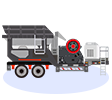In industries such as mining, construction aggregate production, and cement manufacturing, the hammer crusher is a highly efficient and reliable crushing equipment widely used for crushing various hardness materials. This article will introduce the usage and precautions of the hammer crusher to help you better utilize this equipment and improve production efficiency.
Working Principle of Hammer Crusher
The hammer crusher mainly relies on the impact of the hammers on the high-speed rotating rotor to crush the materials. When the material enters the crushing chamber, it is broken by the high-speed impact of the hammers. At the same time, the material is further crushed by mutual collisions and collisions with the inner wall of the crushing chamber. Finally, the crushed material is discharged through the screen plate, completing the crushing process.
Usage Instructions
1. Inspect the Equipment: Before starting, check whether all parts of the crusher are intact, whether the fasteners are loose, and whether the drive belt is properly tensioned.
2. Adjust the Clearance: Adjust the clearance between the hammers and the screen plate according to the particle size of the material you need to crush. An overly small clearance can affect the output, while an overly large clearance can lead to uneven particle size.
3. Feed Material Uniformly: After starting the equipment, feed the material evenly and continuously to avoid overloading the equipment.
4. Monitor Operation: During the operation of the equipment, regularly check the temperature of the motor, bearings, and the sound inside the crushing chamber to ensure the equipment is running normally.
5. Regular Maintenance: Regularly lubricate, clean, and inspect the equipment, and replace worn hammers and screen plates in time to ensure the performance and lifespan of the equipment.
Precautions
1. Safe Operation: Operators should wear protective gear and avoid approaching the crushing chamber when the equipment is running to prevent injury from flying materials.
2. Material Selection: Hammer crushers are suitable for crushing brittle materials and should be used cautiously for materials with high water content and strong adhesion.
3. Prevent Overloading: Avoid overloading the equipment to prevent damage. If too much material is found, stop feeding immediately.
4. Regular Inspection: After the equipment has been running for a period of time, a comprehensive inspection should be carried out, including checking the wear of the hammers and screen plates, as well as the operating status of the motor and bearings.
5. Environmental Adaptation: The hammer crusher should be placed on a flat and solid ground to avoid excessive vibration due to uneven ground.
Conclusion
The hammer crusher plays an important role in industrial production with its high crushing efficiency and wide applicability. Using and maintaining the hammer crusher correctly can not only improve production efficiency but also extend the service life of the equipment. I hope this introduction will help you better understand and use the hammer crusher, bringing convenience to your production operations.












